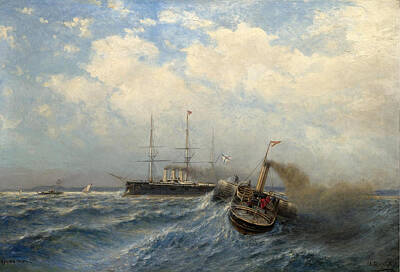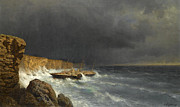Alexey Bogolyubov
Paintings
View Of The Naval Port At Copenhagen From The Windows Of Amalienborg Palace
View Of The Grand Palace. Livadia
Quayside In Sinop On The Black Sea

The final moments of the imperial yacht Livadia

The rostral column near the stock exchange, St Petersburg

The Port Of Le Havre. Normandy
Fine Art Prints | Greeting Cards | Phone Cases | Lifestyle | Face Masks | Men's , Women' Apparel | Home Decor | jigsaw puzzles | Notebooks | Tapestries | ...
Alexey Petrovich Bogolyubov (Russian: Алексей Петрович Боголюбов; 16 March 1824 – 3 February 1896) was a Russian landscape painter. In 1841, Alexey graduated from military school, serving in the Russian Navy and travelling with the fleet to many countries. In 1849, he started to attend classes of the Saint Petersburg Academy of Arts, where he studied under Maxim Vorobiev. The young painter was greatly influenced by Ivan Aivazovsky. In 1853, he finished the Academy with a major Gold medal. He retired as a navy officer and was appointed an artist to the Navy headquarters. From 1854 to 1860, he travelled around Europe and worked prolifically. In Rome, he was acquainted with Alexander Ivanov, who convinced Bogolyubov to focus more on drawing. In Düsseldorf, Bogolyubov took classes from the painter Andreas Achenbach. In Paris, he admired the artists of the Barbizon School. French painters Camille Corot and Charles-François Daubigny were good friends and collaborators with Bogolyubov. He also painted the frescoes in the Alexander Nevsky Cathedral.
Bogolyubov returned to Russia in 1860. He exhibited his works in the Academy and received the title of professor. For some time, he taught in the Academy. In the 1860s, he traveled along the Volga. His paintings lost all traces of Romanticism, replacing that element with staunch realism of the natural. In 1871 he was elected to the Imperial Academy of Arts.
Sailing ships, 1860
From 1870, he became close to the The Wanderers art movement, participated in all their exhibitions. He became a member of their board. Much older than most of the other members of the movement, he had reservations on their social ideas. In 1873, Bogolyubov left the Academy in solidarity with his fellow Itinerants. He even tried to create an alternative Russian Academy of Arts in Rome.[1]
After 1873, Bogolyubov lived primarily in Paris, because of his heart condition. His house was like a Russian colony: frequent visitors included Ivan Turgenev, Ilya Yefimovich Repin, Vasily Polenov, Mark Antokolski, Vasili Vasilyevich Vereshchagin.[1]
Opening of Radischev Art Museum in Saratov
In 1885, Bogolyubov opened an art museum in Saratov, the Radischev Art Museum, named after his grandfather. It was opened to the general public seven years earlier than the Tretyakov Gallery in Moscow and fifteen years earlier than the Russian Museum in Saint Petersburg.[2] The naming of the museum after the "first Russian revolutionary", Alexander Radishchev, was a direct challenge to the authorities: Bogolyubov had to endure a legal battle to get permission.
Bogolyubov died on 3 February 1896 in Paris. After his death, Bogolyubov left all his money and capital (around 200 thousand Russian rubles (approximately US$6 million) to the museum and its painting school.[1] The school was opened after Bogolyubov's death and named Bogolyubov's Painting School (Боголюбовское Рисовальное Училище).[1] Among painters who attended Bogolyubov's School were such important modernist painters as Victor Borisov-Musatov and Pavel Kuznetsov.
Footnotes
Alexey Bogolyubov (Russian) article
Bogolyubov page on the site of Saratov Radischev Museum (Russian)
References
Bogoliubov. by M. I. Andronnikova. Moscow. 1962
External links
Alexey Bogolyubov Notes of an Sailor-Artist (Russian)
Artist
A - B - C - D - E - F - G - H - I - J - K - L - M -
N - O - P - Q - R - S - T - U - V - W - X - Y - Z
Retrieved from "http://en.wikipedia.org/"
All text is available under the terms of the GNU Free Documentation License



















